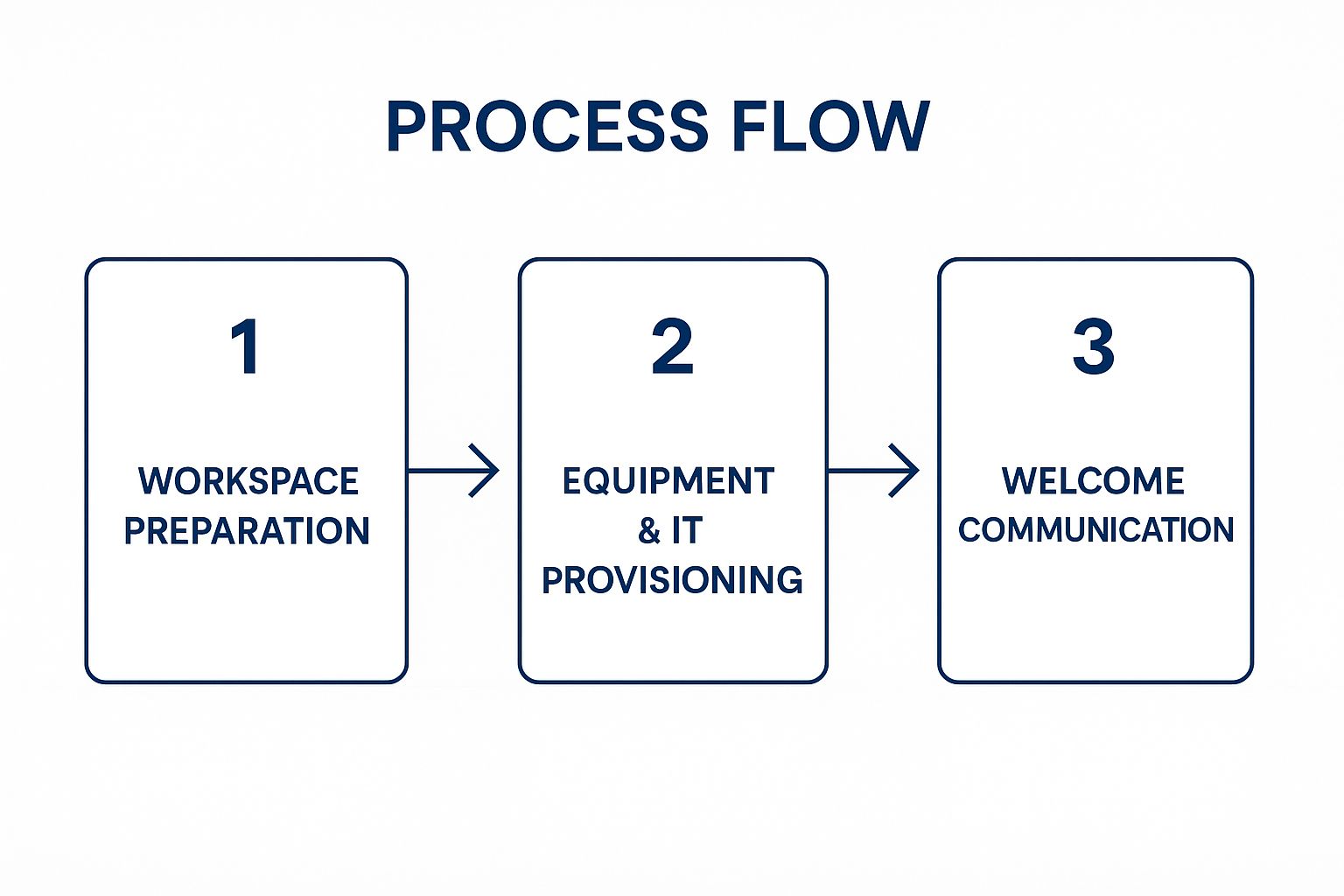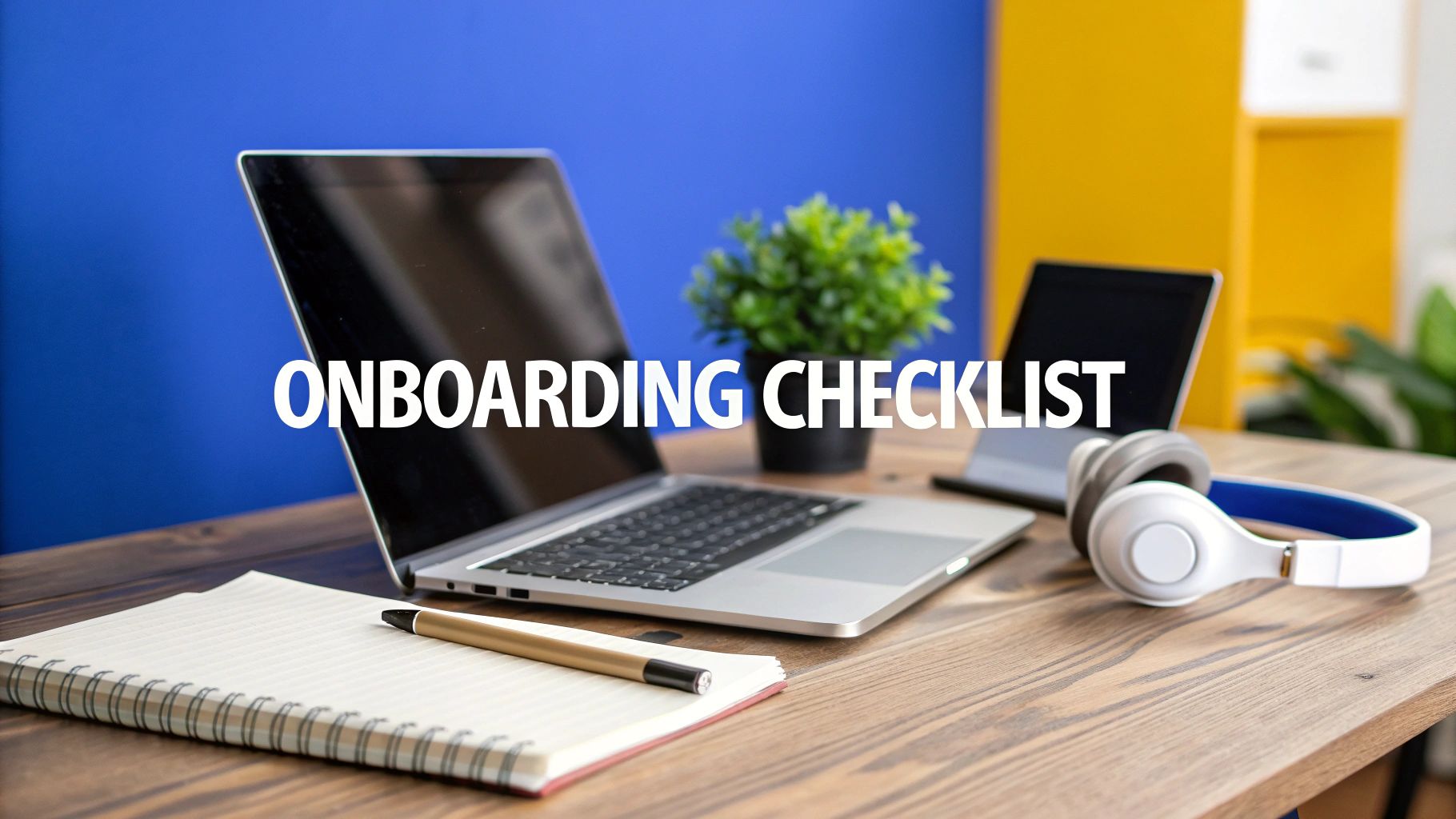In the modern workplace, especially when hiring top-tier remote talent, a successful start is not a matter of chance; it is the result of a meticulously planned onboarding process. A haphazard welcome can lead to disengagement, confusion, and costly early turnover. Conversely, a structured and thoughtful experience empowers new hires, accelerates their time to productivity, and deeply integrates them into your company culture from their very first interaction. This is particularly crucial for remote teams, where clear communication and proactive support replace informal office chats.
This guide presents the ultimate new employee onboarding checklist, specifically tailored for small to medium-sized enterprises (SMEs) navigating the unique challenges and opportunities of building a remote team. We will break down the entire journey, from the moment an offer is accepted right through to the crucial 90-day milestone. The checklist covers everything from pre-boarding paperwork and IT setup to cultural integration and performance reviews. For instance, ensuring your new hire is fully briefed on essential security practices for remote workers is a non-negotiable step for protecting company data from day one.
By following this comprehensive plan, you can transform onboarding from a simple administrative task into a powerful strategic advantage. You will learn how to create a welcoming, efficient, and effective process that sets every team member up for long-term success, ensuring they feel prepared, supported, and valued from the outset.
1. Pre-boarding Preparation
The journey to a successful employee integration begins long before their first official day. Pre-boarding encompasses all the crucial activities you complete between the candidate accepting their job offer and their start date. This phase is your first opportunity to make a lasting impression, demonstrating organisational efficiency and a welcoming culture. By proactively handling administrative tasks, IT setup, and initial communications, you can significantly reduce first-day jitters and ensure your new hire feels valued and prepared from the outset.
A well-structured pre-boarding process transforms a potentially anxious waiting period into an engaging and reassuring experience. It sets a positive tone, confirming to the new employee that they made the right decision in joining your team. This initial phase is a cornerstone of any effective new employee onboarding checklist, laying the groundwork for a smooth transition and long-term engagement.
Key Pre-boarding Activities
To ensure nothing is missed, focus on three core areas: workspace, technology, and communication.
- Workspace & Documentation: For remote employees, this means ensuring they have a clear understanding of home office requirements and that all necessary HR paperwork (contracts, tax forms, policy acknowledgements) is sent, signed, and returned digitally. Using an e-signature platform can streamline this process significantly.
- IT & Equipment Setup: Coordinate with your IT department at least a week in advance. Laptops, monitors, and other peripherals should be configured with necessary software and security access, then shipped to arrive a few days before the start date. This includes creating email accounts, and granting access to essential platforms like Slack, Teams, and project management tools.
- Welcome & Orientation: A simple, warm welcome can make a world of difference. Send a welcome email 3-5 days before their start date, including the first-day schedule, login details, and who they'll be meeting. Consider sending a welcome pack with company swag like a branded mug, notebook, or t-shirt to help them feel part of the team.
This simple workflow diagram illustrates the logical sequence of pre-boarding tasks to ensure a smooth start for your new hire.

Following this sequential process prevents logistical bottlenecks, such as a new employee having their laptop but no login credentials to use it.
2. Documentation and Paperwork Processing
While less glamorous than a welcome pack, the systematic collection and processing of employment paperwork is a non-negotiable part of onboarding. This stage involves handling all legal, regulatory, and administrative documents required to formalise the employment relationship. Properly managing this ensures legal compliance, establishes clear terms, and protects both the company and the new hire. It's the administrative backbone of a secure and professional start.
Efficiently handling paperwork demonstrates your company's organisation and respect for the employee's time. A clunky, paper-heavy process can create friction and frustration, whereas a streamlined, digital-first approach reinforces a modern and efficient company culture. Getting this right is a critical component of any new employee onboarding checklist, as it prevents administrative delays that could impact payroll, benefits, and system access.
Key Documentation Activities
To create a seamless and compliant process, focus on digitisation, clarity, and security.
- Digitise & Automate: Wherever legally permissible, transition from paper forms to digital ones. Platforms like BambooHR and DocuSign allow for the easy distribution, completion, and signing of documents such as employment contracts, tax forms (like the P45 or starter checklist), and policy acknowledgements. This is especially vital for remote teams, eliminating the need for printing, scanning, and postage.
- Provide Clear Guidance: Don't just send a batch of forms. Provide a clear checklist, brief explanations for each document, and examples of how to complete complex sections. Scheduling a brief, dedicated 30-minute session on the first day to walk through the paperwork can answer questions in real-time and prevent errors, ensuring a smoother process than leaving the employee to figure it out alone.
- Ensure Security & Compliance: Employee documents contain highly sensitive personal information. Use a secure, centralised system like Workday or ADP for storing and managing these files. Ensure your processes are GDPR compliant, clearly stating how data will be used and stored. This builds trust and demonstrates a commitment to data privacy from day one. You can learn more about the importance of thorough background checks and compliance in the pre-employment screening process.
3. IT Setup and System Access Provisioning
Seamless access to technology is the backbone of productivity for any new starter, especially in a remote setting. IT setup and system access provisioning covers the entire process of equipping your new employee with the necessary hardware, software, and permissions to perform their role effectively. This critical stage involves configuring and distributing physical equipment, creating digital accounts, and carefully assigning access rights across all relevant company platforms. A disorganised IT process can lead to significant first-week frustration and lost productivity, undermining an otherwise positive onboarding experience.
Getting this right demonstrates your company's professionalism and commitment to setting employees up for success. By meticulously planning and executing IT provisioning, you ensure the new hire can hit the ground running, integrate smoothly into digital workflows, and feel empowered from day one. This element is a non-negotiable part of a modern new employee onboarding checklist, directly impacting a new hire's ability to contribute and connect with the team.

For small to medium-sized enterprises, managing this process in-house can be demanding. This is where exploring options such as outsourcing IT services can provide expert support, ensuring security and efficiency without straining internal resources.
Key IT Provisioning Activities
A structured approach to IT onboarding prevents security gaps and logistical delays. Focus on three critical pillars: automation, access control, and support.
- Automated Provisioning & Hardware Setup: Use modern deployment tools to streamline the setup process. Services like Apple's Device Enrolment Program or Microsoft's Windows Autopilot allow for zero-touch configuration, where devices are shipped directly to the employee and automatically configure with company policies and software upon their first login. This saves immense time for your IT team.
- Role-Based Access Control (RBAC): Create pre-defined access templates for different roles within your organisation. For example, a new marketing analyst should automatically receive access to Google Analytics, your CRM, and social media scheduling tools. Platforms like Okta can automate this user provisioning, ensuring employees get the exact access they need, no more and no less, which is crucial for security.
- Clear Instructions & Support: Never assume technical proficiency. Provide the new hire with a "Digital First Day" guide that includes login credentials, links to key systems, step-by-step setup instructions, and tutorials for core software. Crucially, clearly outline the process for seeking IT support, including who to contact and the expected response times for any issues they encounter.
4. Workplace Orientation and Office Tour
A structured orientation to the workplace is about more than just showing a new hire where the coffee machine is. It is a critical process of immersing them in the physical and cultural environment of your company. This step involves a comprehensive tour of the facilities, essential safety briefings, and an introduction to the unwritten rules and norms that define your workplace culture. A well-executed orientation helps new employees feel comfortable, confident, and connected from day one.
By familiarising new starters with their surroundings, you empower them to navigate their new role with greater ease and independence. This part of the new employee onboarding checklist is crucial for bridging the gap between being an outsider and feeling like a true member of the team. It transforms an abstract workplace into a tangible, welcoming space, laying the foundation for productivity and a sense of belonging.
Key Orientation Activities
A successful tour should be both practical and inspiring. Companies like Google and WeWork have popularised this by creating immersive experiences that showcase innovation and community.
- Guided Tour & Key Locations: Lead a comprehensive tour covering essential areas: their dedicated workspace, meeting rooms, breakout areas, kitchens, and restrooms. Also, point out crucial health and safety locations, such as fire exits, first aid stations, and designated assembly points. Introducing them to key departmental figures they pass along the way helps build early connections.
- Cultural & Amenity Immersion: Use the tour to bring your company culture to life. Highlight collaborative spaces, wellness rooms, or unique office perks that reflect your values. Explain the unspoken etiquette, such as hot-desking policies or communication norms in common areas. This helps the employee understand how to engage with the space and their colleagues appropriately.
- Virtual Tour for Remote Staff: For remote employees, a physical tour isn't possible, but orientation remains vital. Create a pre-recorded video tour or host a live virtual walkthrough. Use this session to introduce them to the digital "office," explaining how to use communication platforms like Slack or Teams for different purposes and showcasing your digital collaboration tools.
This video from an Airbnb host provides an excellent example of how to conduct a welcoming and informative tour, a principle that translates directly to onboarding a new team member.
Whether physical or virtual, a thoughtful orientation makes the new environment feel less intimidating and more like home.
5. Role-Specific Training and Job Orientation
Once a new hire understands the company culture and general policies, the focus must shift to equipping them for their specific role. Role-specific training moves beyond broad orientation to provide the targeted knowledge, skills, and competencies required to excel in their unique position. This stage is about translating company goals into individual responsibilities, ensuring the employee understands exactly what is expected of them and how to achieve it.
This tailored approach is critical for building confidence and accelerating productivity. A new marketing coordinator needs different training from a new software developer, and recognising this distinction is vital. By providing customised learning paths, you demonstrate a commitment to their professional growth and set them on a clear path to success. This targeted development is a non-negotiable part of a comprehensive new employee onboarding checklist, ensuring a new hire can contribute meaningfully, faster.
Key Role-Specific Training Activities
To build competence and confidence, your training plan should be practical, structured, and directly tied to job functions.
- Customised Learning Modules: Break down the role's complexities into digestible modules. For a finance clerk, this might include separate sessions on using your specific accounting software, processing invoices, and running month-end reports. Avoid overwhelming them with everything at once; a phased approach is more effective.
- Hands-on Practice & Shadowing: Theory is important, but practical application is essential. Set up simulated tasks or projects that mirror real-world responsibilities. Arrange for the new hire to shadow an experienced team member to see how processes are handled in real-time, followed by having the mentor observe them performing the task.
- Performance & Progress Checkpoints: Define clear performance expectations and milestones for the first 30, 60, and 90 days. Schedule regular check-ins to discuss progress, answer questions, and provide constructive feedback. This helps the employee understand where they stand and what they need to focus on. For comprehensive insights on delivering truly engaging employee training, consider exploring modern interactive approaches.
6. Team Introductions and Relationship Building
Beyond understanding their role, new employees must build the social and professional connections that enable collaboration and foster a sense of belonging. Team introductions are not just a first-day formality; they are a structured process of integrating a new hire into the fabric of your organisation. This phase involves a carefully planned series of interactions designed to establish key working relationships, open lines of communication, and help the newcomer understand the team's dynamics and culture.

A strategic approach to introductions moves beyond a quick "hello" in a team meeting. It involves providing context for each new relationship and creating opportunities for both formal and informal connection. This deliberate effort is a crucial part of any new employee onboarding checklist, as it accelerates the new hire's ability to navigate the organisation, seek help when needed, and contribute effectively to team projects. Companies like Zappos and Buffer have demonstrated that prioritising these early connections leads to higher engagement and a stronger, more cohesive culture.
Key Activities for Relationship Building
To foster meaningful connections, your onboarding plan should include a mix of structured and casual interactions spread across the first few weeks.
- Structured One-to-Ones: Schedule a series of 30-minute introductory meetings with key team members, direct reports, and cross-functional stakeholders. Provide the new hire with a "stakeholder map" that includes names, roles, and a brief note on how their roles intersect. This gives them context and helps them prepare relevant questions.
- Team Welcome Rituals: Organise a specific welcome activity during the first week. This could be a team lunch (virtual or in-person), a casual coffee chat, or a dedicated "get to know you" session with fun icebreakers. For remote teams, an informal video call focused purely on non-work topics can be highly effective.
- Facilitate Broader Connections: Don't limit introductions to the immediate team. Assigning an onboarding "buddy" from a different department can provide a safe space for asking questions and learning about the company from another perspective. Also, ensure the new employee is added to relevant social channels or groups where informal conversations happen. For more structured improvement in team interactions, you can explore communication skills training for your employees to enhance collaboration across the board.
7. Company Culture and Values Integration
Effective onboarding goes far beyond processes and tasks; it's about connecting a new hire to the very heart of your organisation. Culture and values integration involves a deliberate programme to help employees understand, embrace, and embody your company's mission, vision, and behavioural norms. This isn't just about handing them a values statement, but about showing them how those values translate into everyday decisions, interactions, and work practices.
For a new starter, understanding the "why" behind the "what" is crucial for engagement and long-term alignment. A robust culture induction ensures they don't just learn their job but also learn how to succeed within your unique environment. This step is a vital part of any new employee onboarding checklist, as it transforms a new hire from a temporary outsider into a true, integrated member of the team.
Key Culture Integration Activities
To foster deep cultural alignment, focus on making your values tangible and relatable from day one.
- Storytelling & Real-World Examples: Move beyond abstract definitions. Use storytelling during orientation to illustrate your values in action. Share specific anecdotes of how a team member embodied a core value to solve a problem or delight a customer. For example, if "innovation" is a value, share the story of a failed experiment that led to an important lesson, normalising risk-taking.
- Leadership Involvement: Culture is set from the top. Arrange sessions where senior leaders authentically share their personal connection to the company's mission and values. This shouldn't be a formal, scripted presentation but a genuine conversation that demonstrates leadership's commitment. A CEO spending 30 minutes with new hires to discuss the company's founding story is far more impactful than a paragraph in a handbook.
- Interactive Values-Based Discussions: Create dedicated time for new employees to discuss the company culture with their peers and manager. Use scenario-based exercises, asking, "In this situation, how would our values guide your response?" This helps them practise applying cultural principles to practical work challenges, cementing their understanding in a low-stakes environment. Companies like Netflix famously use their culture deck as a living document to fuel these kinds of conversations.
8. 30-60-90 Day Check-ins and Progress Reviews
The initial 90 days are a critical period that often determines a new hire's long-term success and retention. A structured 30-60-90 day check-in plan provides a formal framework for monitoring progress, providing feedback, and addressing challenges. These regular, dedicated touchpoints between the new employee and their manager ensure that expectations are aligned, support is continuous, and any potential integration issues are identified and resolved early.
This systematic approach moves beyond ad-hoc catch-ups, transforming the onboarding experience into a guided journey of growth and adaptation. It signals to the new hire that their development is a priority and provides a clear pathway for them to become a fully contributing team member. Companies like Google and Adobe have championed this model, recognising that continuous, structured feedback is fundamental to building an engaged and high-performing workforce. This element is a non-negotiable part of any modern new employee onboarding checklist.
Key Check-in Activities
To maximise the effectiveness of these reviews, each milestone should have a distinct focus while maintaining a consistent structure.
- 30-Day Check-in: This first review focuses on assimilation and understanding. The conversation should cover the employee's grasp of their role, their initial experience with company culture, and any immediate roadblocks. The goal is to ensure they feel supported and have the basic tools and knowledge needed to proceed.
- 60-Day Check-in: The focus shifts towards contribution and skill application. Discussions should revolve around progress on initial projects, collaboration with the team, and identifying any skill gaps or training needs. This is an opportunity to provide more specific, performance-related feedback and adjust initial goals.
- 90-Day Check-in: This final milestone review evaluates performance against initial expectations and sets future goals. It's a forward-looking conversation about long-term career development, solidifying the employee's role within the team and transitioning them from an "onboarding" phase to a fully integrated team member. Documented feedback from this meeting can serve as a baseline for future performance reviews.
8-Point New Employee Onboarding Comparison
From Checklist to Culture: Embedding Onboarding Excellence
Navigating the journey from a candidate’s acceptance to a fully integrated and productive team member is one of the most critical processes for any small or medium-sized enterprise. The detailed new employee onboarding checklist we have explored, from pre-boarding preparation and IT setup to culture integration and the pivotal 30-60-90 day reviews, provides a robust blueprint for success. This isn't just about ticking boxes; it's about building a foundational experience that sets the tone for an employee's entire tenure with your company, especially in a remote or hybrid environment.
By diligently implementing these steps, you transform onboarding from a procedural formality into a strategic advantage. You create a repeatable, scalable system that ensures every new hire, whether they are in the next room or another time zone, feels welcomed, valued, and empowered from their very first interaction. This systematic approach demystifies the organisation, clarifies expectations, and accelerates the new starter's journey to becoming a confident, contributing member of the team.
From Good to Great: Elevating Your Onboarding Strategy
A truly exceptional onboarding programme is a living entity, one that evolves with your company and adapts to the feedback you receive. To move beyond a simple checklist and foster genuine excellence, consider these actionable next steps:
Formalise a Feedback Loop: After the 90-day mark, schedule a dedicated feedback session. Ask specific questions: "Which part of the onboarding process was most helpful?" and "Where did you feel you needed more support?" Use this direct input to refine your process for the next hire. This continuous improvement is what separates adequate onboarding from an outstanding experience.
Automate Where Possible: For SMEs, time is a precious resource. Utilise HR software or project management tools (like Trello or Asana) to create a template for your new employee onboarding checklist. This ensures consistency and frees up your team to focus on the high-touch, human elements of onboarding, such as one-to-one meetings and team introductions.
Expand Your Knowledge Base: The principles of a great welcome are universal. To truly embed onboarding excellence and foster a positive new hire experience, it's beneficial to draw insights from broader best practices. Explore established customer onboarding best practices to discover transferable strategies for creating clear communication, setting expectations, and guiding new individuals toward success. The core goal is the same: making a complex process feel simple and supported.
The Lasting Impact of a World-Class Welcome
Mastering your onboarding process delivers benefits that extend far beyond the first few months. A strong start directly correlates with higher employee engagement, improved long-term retention, and faster time-to-productivity. When employees feel they have been set up for success, their loyalty and commitment to the company's mission deepen significantly. This is especially crucial for SMEs looking to build a resilient, high-performing team that can drive sustainable growth.
Key Takeaway: The ultimate goal of your onboarding checklist is not just to prepare someone for a job; it is to integrate them into a culture. It is the first and most powerful demonstration of your company's values, communication style, and commitment to its people.
Finding the right talent is only the beginning. The real work lies in nurturing that talent through a thoughtful, comprehensive, and human-centric onboarding experience. By turning your checklist into a cornerstone of your company culture, you build more than just a workforce; you build an engaged, unified, and unstoppable team ready to achieve remarkable things together.

